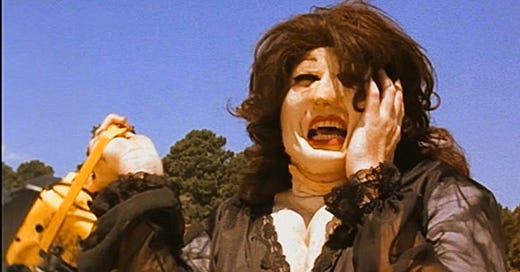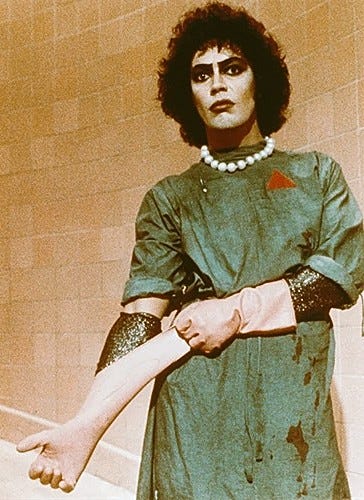Body horror is the subgenre of horror concerned with the disturbing violation of the basic structure of the human form.
[…]
[It’s] about the human body being transformed beyond its natural limits. This is rarely a result of direct violence, it's not about injury or bloodshed. Instead, body horror is about disease, mutilation, invasion, and corruption from within. Parasites that warp their hosts, tumors that rot their suffering victim from within, or innocent people transformed into something else entirely by unethical tampering [emphasis added].
—Body Horror: The Key Elements That Define The Genre (Game Rant)
This description of the body horror subgenre—and though I’m sure the author of the article would take great umbrage at such a comparison—could just as easily describe the horrors of so-called “gender-affirming surgery.” Surgery in general isn’t for the faint of heart, but the graphic details of what occurs during a sex-change operation in particular go far beyond even the morbid imaginations of the most depraved Hollywood screenwriters.1
Indeed, transgenderism itself is an inherently horrific concept: from the operating room mutilations carried out by Dr. Frankenstein-inspired surgeons who rearrange otherwise healthy body parts into gross facsimiles of reproductive organs, to the repeated painful injections into the bloodstream of carcinogenic chemicals and hormones that wreak havoc on the endocrine system, and the use of sadistic tools like chest binders and artificial vagina dilators that give medieval torture devices a run for their money.2
But there’s also an aspect of psychological horror at play: the tragic terror of feeling like you were born inside the wrong body (coinciding with disproportionate rates of suicide in those suffering with body dysmorphia) and the dissociative identity disorder-like demand to be referred to in the plural as a “they/them”—a notion that veers even further toward supernatural horror when compared to cases of demonic possession (my name is Legion, for we are many) and the Satanic veneration of androgynous demons like Baphomet.
And then there’s the more subtle, subliminal creepiness of a man pretending to be a woman or vice versa—the uncanny valley of mendacious eeriness where something (or in this case someone) is not quite right…3
Drag queens take the opposite approach, of course, trading in unsettling subtlety for over-the-top audacity. Instead of the “normal” M.O. of male-to-female transitioners trying (and failing) to pass themselves off as women, the drag queen dresses up as an intentional parody of femininity, with giant wigs, clownish makeup, and absurd attire, the end result making them look less like a woman and more like an evil witch out of a campy horror comedy.
The drag/demon connection is made explicit time and time again, whether in transgressive movies like John Waters’ 1970 “black comedy” Multiple Maniacs (in which a serial killing drag queen called “Divine” revels in on-screen blasphemy and sacrilege); the opening ceremony of the 2024 Paris Olympics (which notoriously featured a perverse parody of the Last Supper); and countless cases of the nightmare-inducing “Drag Queen Story Time,” in which innocent children are subjected to trans terror (complete with devil horns) up close and personal.
Even putting aside its diabolic, preternatural implications, trans terror makes sense from a purely evolutionary perspective: seeing a man in a dress activates the fight-or-flight instinct because it’s a blaring warning signal that the person in front of you is mentally unwell and thus dangerous and unpredictable.
South Park made fun of the “trans inclusive” trend of male athletes competing in women’s sports back in 2019, exposing the concept’s inherent ridiculousness by having a “Macho Man” Randy Savage-like “woman” dominate a “Strong Woman” competition, to the point where one of the (actually female) competitors is left bruised and bloody while the musclebound “trans woman” celebrates his victory.4 This seemingly absurd bit of satire would become reality just a few years later when a female boxer had to call it quits during a match after being beaten up so badly by her man-pretending-to-be-a-woman opponent that she feared for her life.
Unethical experimentation, part and parcel of “gender-affirming care,” is a staple of mad scientist stories, from The Island of Doctor Moreau to The Human Centipede. They’re upsetting not just as crimes against humanity, but crimes against God Himself, upending the natural order of His creation. Another mad scientist who becomes a (albeit unintentional) trans terror is Dr. Brundle (as played by Jeff Goldblum) in the 1986 version of The Fly, where the character’s physical and mental decline as he slowly transitions into something less than human is shown in all its nauseating detail.
The subgenre of body horror and its trans terror variant is not to be confused with the many pro-trans propaganda pieces from Hollywood that celebrate transgenderism as empowering and inspirational. These Oscar-bait movies5 are invariably lauded as important truth-to-power works of art and the actors’ “brave” performances are inevitably heaped with praise and awards.6
The concept of trans terror itself is mostly tackled in less Oscar-friendly horror films with various degrees of self awareness. From the Bearded Lady and Half Woman-Half Man in Freaks, to Norman Bates dressing up like his mother in Psycho, and even the lipstick-wearing, crossdressing Leatherface in Texas Chainsaw Massacre, it used to be taken for granted that gender bending was, at the very least, weird, and thus perfect fodder for horror.
By the latter half of the 20th Century, however, such unflattering depictions began to garner more controversy and pushback from activists and agitators. Brian DePalma’s Psycho homage Dressed to Kill, in which Michael Caine plays a psycho-therapist who moonlights as a crossdressing murderer, and Jonathan Demme’s Silence of the Lambs, where Anthony Hopkins’ iconic role of cannibal doctor Hannibal Lector is nearly outstaged in creepiness by the autogynephilic Buffalo Bill, both sparked protests and boycotts for their depictions of transsexual serial killers, decades before the gender madness of the 2010s went full throttle.
The iconic ending of classic ‘80s slasher Sleepaway Camp—in which the ostensibly female killer gives the audience a full frontal gender reveal as a male7—was shocking for its time (though TikTok-brained Zoomers might wonder what all the fuss was about). It garnered less outrage than DePalma and Demme’s more mainstream fare, however, since it was already written off to begin with (like all splatter flicks) as tasteless trash. But the plot twist has received renewed criticism in recent years in light of the pro-trans vibe shift in the culture.
The vibe shift is even more apparent when you watch comedies8 from the 1990s like Ace Ventura: Pet Detective and Mrs. Doubtfire where, instead of an object of horror, men wearing dresses and makeup are fodder for funny punchlines and slapstick ridicule.
Trans terror and campy comedy combined in The Rocky Horror Picture Show9, a freakish film that portrays its transvestites as amoral psychos “lost in space and meaning” but is nonetheless loved and lauded by its trans-friendly cult following.10
The king of body horror, David Cronenberg, has a filmography full of gross trans-coded transformations. In addition to the aforementioned Fly, there’s his 1983 cult classic Videodrome, a movie that ends with the partially metamorphosed main character whispering “Long live the new flesh” before killing himself—a darkly ironic line that could easily serve as an apt rallying cry for trans activists.
Cronenberg’s son Brandon has followed in his father’s sticky footsteps, currently building his own body of body horror work with films like Infinity Pool and Possessor, the latter of which features a female assassin taking over the body of a man in order to take out her target, even going so far as to have intercourse with the man’s wife, thereby further blurring the lines between sex and gender.
Despite how critics may criticize these films as unfair stereotypes, the last few decades have shown us that trans truth is far stranger than its fiction. For as much as trans terror might get flack in film, the real world version is much scarier, with real life trans terrorists committing mass shootings, bombarding critics with rape and death threats, and demanding the right to display their male genitalia in female locker rooms.
As Catholics we are called to be kind to those suffering from the disease of gender dysphoria while condemning the confused culture that enables it. But in doing so let’s not turn a blind eye to its innate grotesquery, for woe to those who call evil good and good evil. Instead of booking an appointment with one of the many Dr. Mengeles who would gladly castrate them for profit, I instead invite the victims of transgenderism to seek the Great Physician, Jesus, Who alone can heal any ailment.
I considered including some gory details to get the point across, but a cursory glance at the Wikipedia page for “feminizing surgery” and its “penile inversion vaginoplasty” was enough to send me running for the nearest bottle of bleach to wash my eyes with.
There’s also a body horror overlap with “old fashioned” homosexuality, with fears of disease and contagion a la the AIDS scare and Monkeypox epidemic.
This one is a bit of a stretch, since the majority of people trying to present themselves as the opposite sex are far from convincing.
South Park enacted an arguably even more thorough evisceration of trans ideology in a 2005 episode where a character comes out of the closet as a “transspecies” dolphin and undergoes a humorously horrific operation in order to accommodate his newfound identity.
Examples include The World According to Garp, The Crying Game, Dallas Buyers Club, and Boys Don’t Cry.
Though even this has shifted in recent years, as identity politicians become increasingly upset when trans characters aren’t portrayed by trans actors (apparently they are unable to grasp the concept of “acting”).
The slasher character Angela’s tragic origin story (a boy forcefully raised as a girl by a psychotic mother) has become a seemingly common occurrence, with so many liberal parents pressuring their prepubescent kids into Munchausen-syndrome-by-proxy gender transitions.
A genre, it should be noted, that was killed by the very political correctness that continues to keep transgender ideology on life support.
I love this story from Jeff Cavins about the time he shut down a screening of Rocky Horror by invoking the Holy Name.
It’s perhaps fitting that the transvestite with top billing, Dr. Frank-N-Furter, is played by Tim Curry, the same actor who portrayed Pennywise the Clown in It and the Satan stand-in in Legend.







